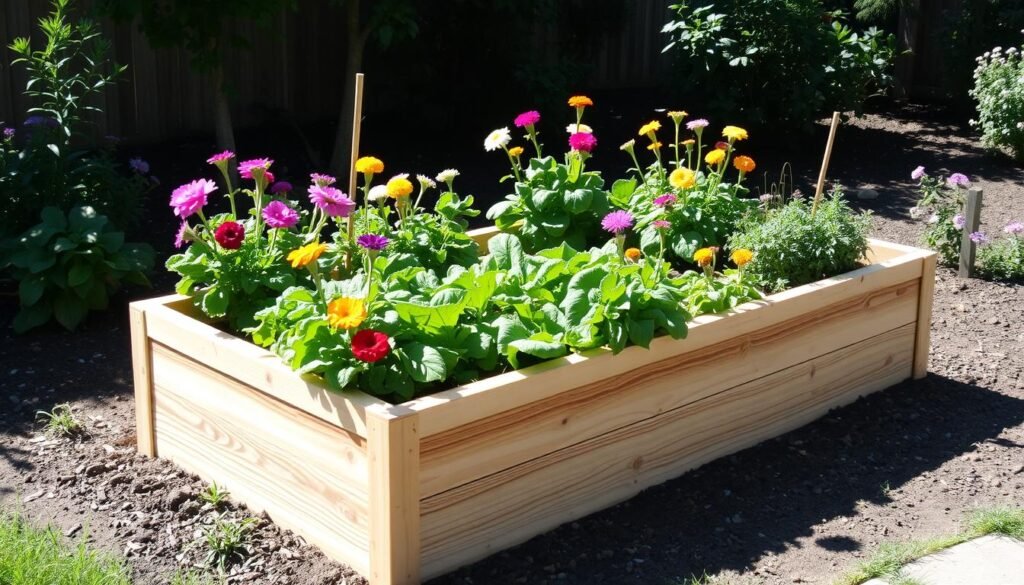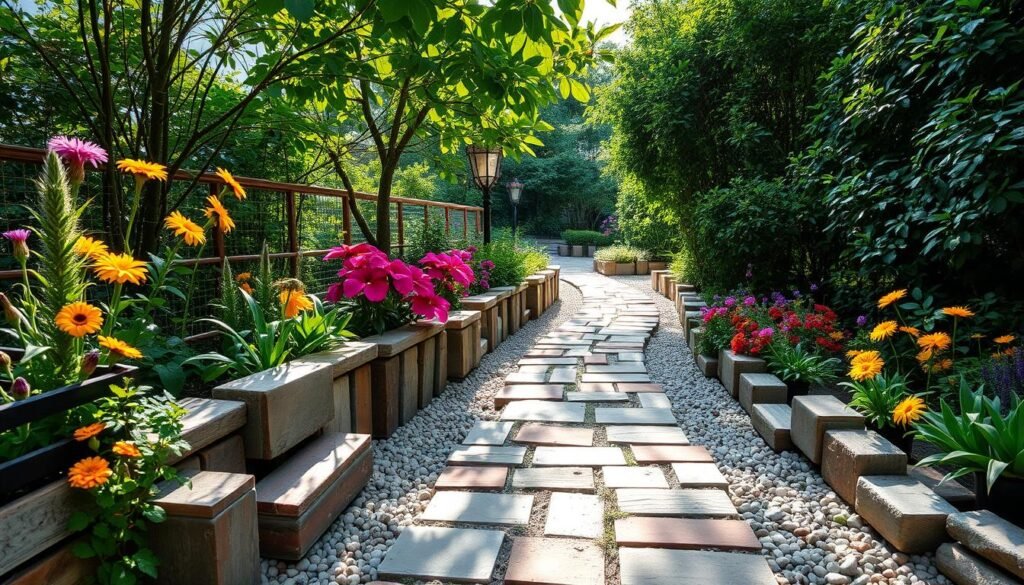Are you ready to transform your kitchen scraps and yard waste into nutrient-rich soil for your garden? Composting is a simple, eco-friendly way to manage organic waste. Building your own compost bin can be a rewarding DIY project. But, where do you start? This comprehensive guide will give you detailed plans for constructing a compost bin that fits your garden perfectly.
You’ll learn essential composting guidelines and discover DIY compost bin designs. You’ll also explore effective garden composting techniques for an eco-friendly solution. Whether you have a small backyard or a sprawling garden, this article will equip you. You’ll learn how to build a customized compost bin that turns waste into valuable soil for your garden.
Have you ever wondered how professional gardeners always have lush, healthy plants? The secret might be in their composting practices. But could it really be that simple? What hidden benefits of composting are they unlocking for their gardens? Dive into this article to uncover the transformative power of homemade compost. Learn how to create your own sustainable waste management system right at home.
Benefits of Composting for Your Garden
Composting is a transformative process that turns organic waste into a valuable soil amendment. It’s a key practice for gardeners, offering both environmental benefits and garden health improvements. By adopting composting, gardeners can lessen their environmental footprint and boost their garden’s health and productivity.
Nutrient-Rich Soil Amendment
The compost produced is a goldmine of nutrients for plants, including nitrogen, phosphorus, and potassium. Adding it to the soil enhances its texture, water retention, and fertility. This creates a perfect environment for plants to grow well, leading to lush, vibrant growth and abundant harvests.
Environmentally Friendly Waste Management
Composting is a green way to handle organic waste, keeping it out of landfills and cutting down on greenhouse gases. By turning kitchen scraps, yard trimmings, and other biodegradable materials into compost, you’re supporting a circular economy. This benefits your garden and the environment broadly.
Composting in your garden is a double win. You get the perks of nutrient-rich soil and eco-friendly waste management. Plus, you’re backing organic gardening and sustainable waste solutions.
| Benefits of Composting | Impact |
|---|---|
| Nutrient-Rich Soil Amendment | Improved soil texture, water-holding capacity, and fertility for healthier, more productive plants |
| Environmentally Friendly Waste Management | Reduced greenhouse gas emissions and diversion of organic waste from landfills |
Planning Your Compost Bin
Before starting your compost bin project, it’s essential to evaluate your garden space and select the appropriate bin size. This initial step ensures your compost bin integrates well with your outdoor environment. It also optimizes the composting process.
Assessing Your Garden Space
Begin by examining the space available in your garden. Consider the layout, access points, and any existing features that could affect the bin’s placement. Measure the area for the bin to ensure it fits without obstructing other garden elements.
Choosing the Right Bin Size
The bin’s size should match the amount of organic waste your household produces. Generally, a family of four needs a bin with a 3 cubic yard (2.3 cubic meters) capacity. Yet, the ideal size can differ based on your specific needs and garden layout.
| Household Size | Recommended Compost Bin Size |
|---|---|
| 1-2 people | 2-3 cubic yards (1.5-2.3 cubic meters) |
| 3-4 people | 3-4 cubic yards (2.3-3 cubic meters) |
| 5+ people | 4+ cubic yards (3+ cubic meters) |
When choosing your bin size, also consider the placement in your garden and suitable DIY designs. This will help you find the perfect fit for your space.
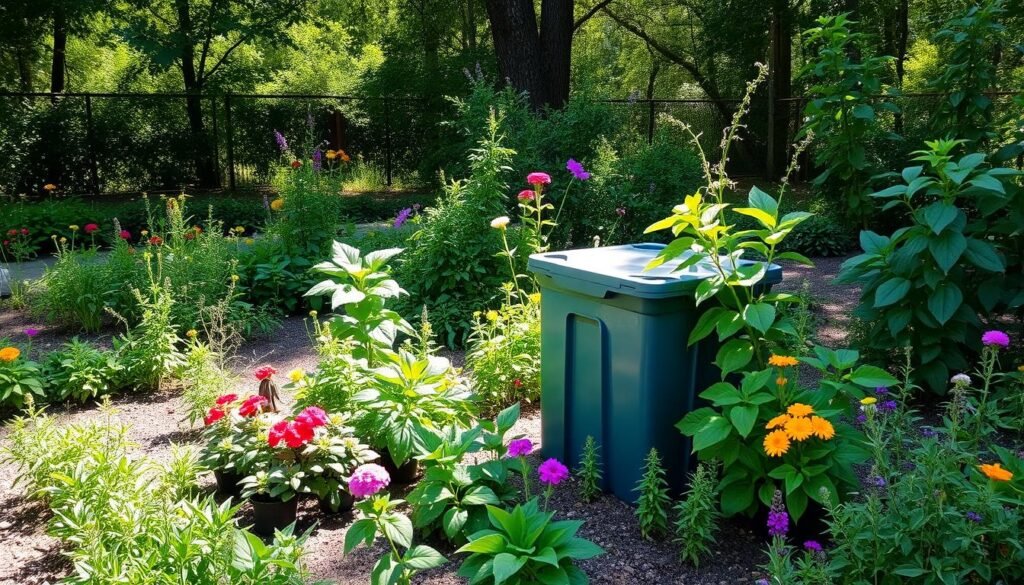
Detailed plans for constructing a compost bin that fits your garden space and needs
Creating the ideal compost bin for your garden is a fulfilling task that boosts your eco-friendly gardening practices. Here, we offer detailed plans and step-by-step guides to build a compost bin that meets your specific needs and garden layout.
Whether you aim to construct a compact bin for a small urban garden or a larger one for a vast backyard, our designs cater to all. We’ll outline the necessary materials and suggest the best sizes based on your garden’s dimensions and composting needs.
Choosing the Right Compost Bin Dimensions
The size of your compost bin should align with your household’s waste output and your garden’s space. Here are some general guidelines:
- For a small household, a 3x3x3 foot bin is typically sufficient.
- For a medium-sized household, a 4x4x4 foot bin is a great option.
- For a large household or extensive gardening needs, a 5x5x5 foot bin may be more appropriate.
Remember, the bin’s size must also consider your garden’s layout. Our detailed plans help you build a custom bin that blends perfectly into your outdoor space.
Constructing the Compost Bin
After deciding on the perfect size and dimensions, it’s time to gather materials and start building. Our step-by-step guide ensures a durable and efficient compost bin that will last for many years.
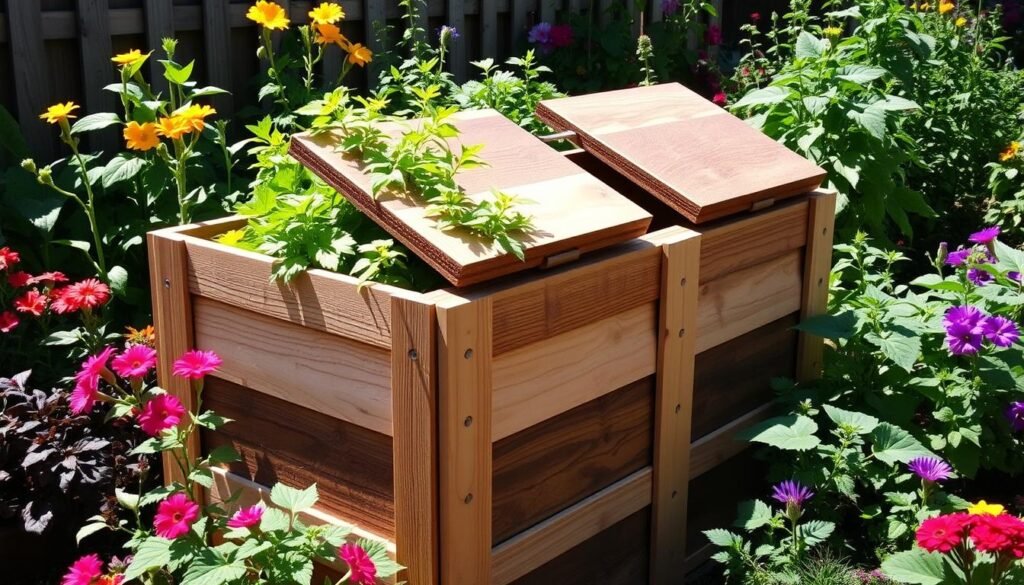
By adhering to these plans, you’ll create a personalized compost bin that meets your garden’s unique needs. It will also enhance your eco-friendly lifestyle.
Essential Materials for Building a Compost Bin
Creating a composting system for your backyard requires the right materials. You’ll need sturdy components and practical accessories. These items are crucial for building a functional and lasting compost bin. Let’s delve into the must-have materials for your DIY composting project.
Structural Components
- Wooden boards or planks for the bin’s frame and walls
- Wire mesh or hardware cloth for the bin’s base and walls
- Hinges and a latch for a removable lid
Accessories and Tools
- A shovel or pitchfork for turning and mixing the compost
- A moisture meter to ensure the right humidity levels
- A compost thermometer to monitor the internal temperature
- Gloves and protective clothing for safe handling
With these essential compost bin materials, you can design and build a sturdy, functional diy compost bin. It will serve your backyard composting systems for years. The right tools and components help create a composting setup. This setup efficiently transforms your organic waste into nutrient-rich soil for your garden.

Step-by-Step Guide to Constructing Your Compost Bin
Turning your garden into a lush, sustainable space begins with creating the right compost bin. Whether you’re a beginner or a seasoned gardener, our guide will help you build a compost bin that suits your needs. It’s all about finding the perfect spot and following our easy steps.
Preparing the Base
Start by picking the best location for your compost bin. Think about accessibility, proximity to your garden, and the bin’s placement. After choosing the right spot, prepare the base:
- Clear the area and level the ground for an even base.
- Consider adding a platform with bricks, stones, or a wooden pallet for better airflow.
- Line the base with twigs or straw for drainage and aeration.
Assembling the Bin Walls
Now, let’s build your compost bin. Follow these steps for a sturdy, functional bin:
- Choose materials like wood, wire mesh, or plastic bins for your bin.
- Measure the bin’s dimensions to ensure it fits your space.
- Assemble the walls, leaving openings for aeration and access.
- Secure the walls firmly for a stable bin that can handle compost weight.
By following these steps, you’ll create a custom compost bin. It will turn your garden waste into nutrient-rich soil for your plants.
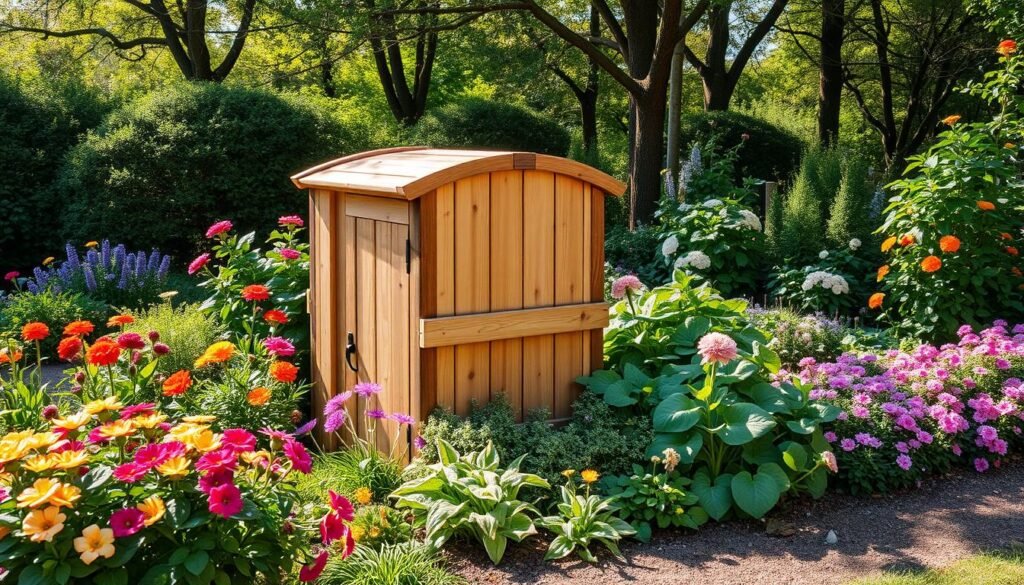
Composting Guidelines and Techniques
Composting is key to turning organic waste into nutrient-rich soil. To compost successfully, understanding the right layering of green and brown materials is crucial. Green materials, like fruit and vegetable scraps, grass clippings, and coffee grounds, add nitrogen. Brown materials, such as dried leaves, shredded paper, and straw, provide carbon, balancing the mix.
Layering Green and Brown Materials
Effective composting relies on the right mix of green and brown materials. Start with a brown layer at the bottom for aeration and drainage. Then, alternate between green and brown layers, with brown materials slightly more. This balance is essential for microorganisms to thrive and efficiently break down the waste.
Keep your compost bin moist but not too wet. Periodically mix the contents to ensure even decomposition. By adhering to these guidelines, you’ll turn your garden waste into a nutrient-rich soil amendment. This will nourish your plants and help your garden thrive sustainably.
FAQ
What are the benefits of composting for my garden?
Composting offers many advantages for your garden. It creates nutrient-rich soil amendments and promotes environmentally friendly waste management. By composting, you enhance your garden’s health and productivity. This is achieved through sustainable and organic gardening practices.
How do I assess my garden space to choose the right compost bin size?
Before constructing your compost bin, evaluate your garden’s space. Measure the area where the bin will reside. Then, select a size that complements your outdoor setup. This ensures the bin fits your garden’s specific needs perfectly.
What are the essential materials needed to build a compost bin?
To create a durable compost bin, gather various materials. You’ll need structural components like wood, wire mesh, or recycled containers. Additionally, accessories such as a lid or aeration system might be required. We’ll outline all necessary items for your DIY composting project.
How do I properly layer green and brown materials when composting?
Proper layering of green (nitrogen-rich) and brown (carbon-rich) materials is key to successful composting. Achieving the right balance of these materials fosters decomposition. This process transforms waste into nutrient-rich soil for your garden. We’ll show you how to layer these materials effectively.
Where should I place my compost bin in my garden?
Choosing the right spot for your compost bin is crucial. Look for a location that’s easy to access and near your garden beds. Consider factors like sun exposure. We’ll offer suggestions for the most efficient placement of your compost bin.
